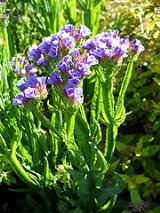
Limonium sinuatum
Encyclopedia
Limonium sinuatum, commonly known as wavyleaf sea-lavender, is a Mediterranean plant species in the family Plumbaginaceae
. It is occasionally seen on the California
coast where it is an introduced species
and landscaping escapee.
. The oblong, lobed leaves are up to 16 centimeters long including winged petioles
. The inflorescence
is a stiff, hairy panicle of flower bunches up to half a meter tall. The flower has blue-lavender sepal
s and pale yellow to white petals.
Plumbaginaceae
Plumbaginaceae is a family of flowering plants, with a cosmopolitan distribution. The family is sometimes referred to as the leadwort family or the plumbago family....
. It is occasionally seen on the California
California
California is a state located on the West Coast of the United States. It is by far the most populous U.S. state, and the third-largest by land area...
coast where it is an introduced species
Introduced species
An introduced species — or neozoon, alien, exotic, non-indigenous, or non-native species, or simply an introduction, is a species living outside its indigenous or native distributional range, and has arrived in an ecosystem or plant community by human activity, either deliberate or accidental...
and landscaping escapee.
Description
This is a perennial herb growing from a woody rhizomeRhizome
In botany and dendrology, a rhizome is a characteristically horizontal stem of a plant that is usually found underground, often sending out roots and shoots from its nodes...
. The oblong, lobed leaves are up to 16 centimeters long including winged petioles
Petiole (botany)
In botany, the petiole is the stalk attaching the leaf blade to the stem. The petiole usually has the same internal structure as the stem. Outgrowths appearing on each side of the petiole are called stipules. Leaves lacking a petiole are called sessile, or clasping when they partly surround the...
. The inflorescence
Inflorescence
An inflorescence is a group or cluster of flowers arranged on a stem that is composed of a main branch or a complicated arrangement of branches. Strictly, it is the part of the shoot of seed plants where flowers are formed and which is accordingly modified...
is a stiff, hairy panicle of flower bunches up to half a meter tall. The flower has blue-lavender sepal
Sepal
A sepal is a part of the flower of angiosperms . Collectively the sepals form the calyx, which is the outermost whorl of parts that form a flower. Usually green, sepals have the typical function of protecting the petals when the flower is in bud...
s and pale yellow to white petals.

